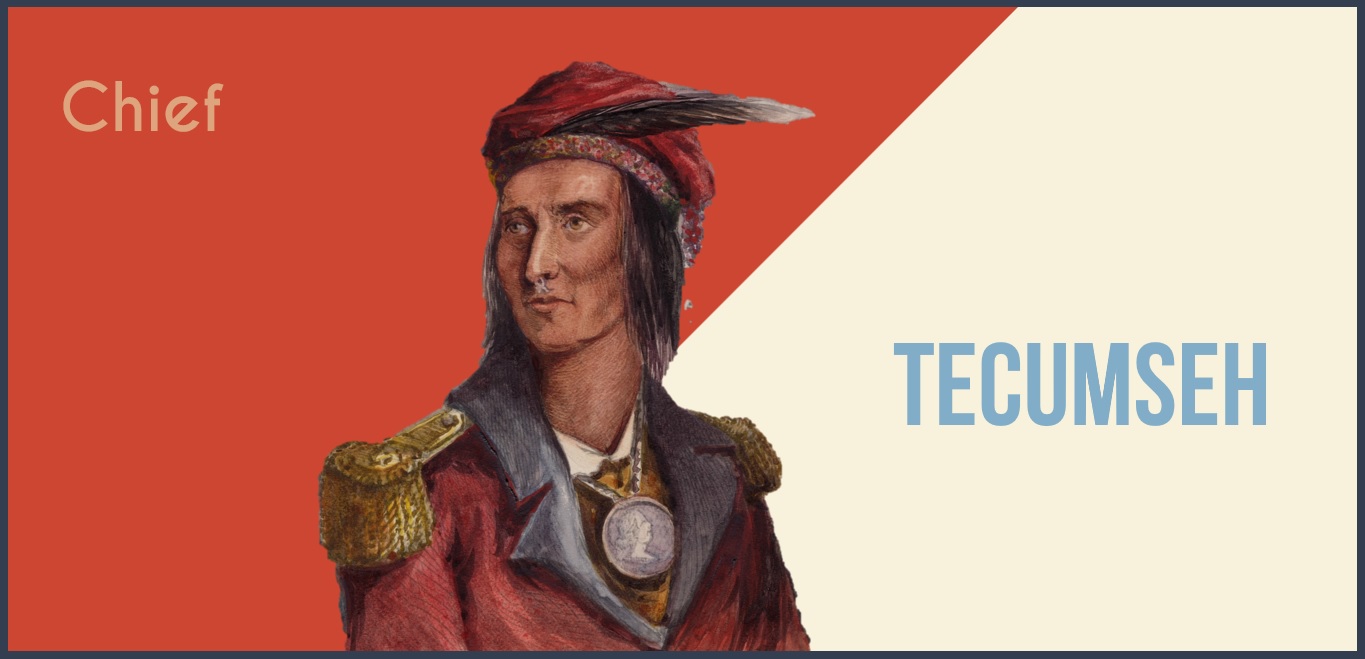Vocabulary
Before reading, translate these words.
Tribe
Native
Indigenous
manifest destiny
conquer
invade
occupy
allied
alliance
territory
impression
unite
expel
war chief
taken aback
torture
homeland
plagued by
prophet
establish
modern-day
appease
upcoming
unprecedented
exclude
negotiation
nullify
recruit
cut off
supply line
march
surrender
reclaim
invade
armistice
retreat
scalp (verb)
folk hero
Biography
Early Life
Tecumseh was born in what is now called Ohio in 1768. He was part of the Shawnee people. His name has been translated as “I cross the way” and “Shooting star.”
When he was young, America declared its independence (1776). The new United States of America believed in manifest destiny. It was the belief that they would conquer all North America. This meant that they invaded and occupied many native lands. The Shawnee did not like the British, but they allied with them to prevent the Americans from invading native land. The British won the territory in 1763 after the French and Indian War.
In 1783, Tecumseh (15 years old) attended a conference of indigenous tribes. He heard Joseph Brant speak about uniting all the tribes. Brant believed that the land belonged to all indigenous people. To hold on to their lands, they needed to come together. No land would be given to the Americans without the permission of all tribes. This idea made a large impression on the young Tecumseh. As an adult, Tecumseh was famous for trying to unite the indigenous tribes.
War Chief
During the Northwest Indian War (1785-1795), the Shawnee joined with the Miami to become a strong fighting group in the Ohio valley. Together, they tried to expel the Americans from the area. Tecumseh became a warrior in 1786. His brother was a war chief. He was taken aback by the way prisoners were treated. He strongly disagreed with torturing prisoners. He would eventually become a minor leader during the war. Unfortunately, the Shawnee lost a major battle (Battle of Fallen Timbers) in 1794 and were forced to give up a large part of their homeland to the Americans. Tecumseh fought in the Battle of Fallen Timbers.
By 1796, Tecumseh was the civil chief and the war chief of the Kipoko band. His band moved around a lot, but eventually settled along the White River, modern-day Indiana. They were plagued by poverty, sickness, alcoholism, loss of land, depopulation, and the decline their traditional lifestyle. Tecumseh’s younger brother, Lalawéthika, was a prophet. Lalawéthika advised Tecumseh to stop drinking alcohol, eat native foods, and wear traditional Shawnee clothing. In 1806, the two brothers established a town together (modern-day Greenville). They tried to re-unite the local bands and tribes. However, the leaders of the Shawnee wanted to appease the Americans by adopting some of the American customs. Lalawéthika message spread across the land. Many native people came to Greenville because of the message.
Settlement
In 1808, the two brothers established the town of Prophetstown (modern-day Lafayette, Indiana). There were rumors of an upcoming war between the British and Americans. They wanted to be closer to their allies. This time, indigenous people of various backgrounds came to Prophetstown. There was an unprecedented variety of Natives living there. The town grew to about 6,000 people and operated as a city-state. They wanted to live in peace with the United States. However, the Treaty of Fort Wayne changed that.
In 1809, the United States purchased over 10,000km2 of land from the natives. But the people who were living on that land were excluded from the negotiations. This upset Tecumseh. He confronted the governor of the Indiana Territory about his. He demanded that the treaty be nullified. When that didn’t work, Tecumseh threatened to unite the native community against him and fight him. Tecumseh spent the next two years recruiting native tribes into his alliance.
The Shooting Star Prophet
The Great Comet of 1811 helped Tecumseh win support. He said it was a sign from the universe that he was coming. After all, his name was “shooting star.” He also promised the tribes that there would be another sign. Later that year, there were a series of earthquakes called the New Madrid Earthquake. Native tribes interpreted this as an omen and joined the alliance. While he was recruiting warriors, the governor of Indiana came to Prophetstown with his army and burned it to the ground.
War of 1812
The War of 1812 began the next year. It was a war between America and the British Empire (Canada). Tecumseh met up with the British in Amerhurstburg to join them. The American General, William Hull, invaded Canada, but was quickly pushed back into the Michigan territory. Tecumseh and his men cut off his supply line. They were able to cut off communication between Hull and the United States. On August 14th, he met up with the British Major-General, Isaac Brock and planned an attack on Fort Detroit. The two men immediately became friends. Tecumseh said, “This is a man!” as a sign of respect towards the Major-General. Tecumseh marched his men in and out of the forest to make it look like his army was much larger than it was. Some of the men wore old British uniforms to change their appearance. Hull surrendered on August 16th.
Brock promised Tecumseh that the British would include natives in any peace agreement. The two also made plans to reclaim Indian territory that the natives had lost to the Americans. They started pushing into American territory, but the British government signed a temporary armistice with the United States, so Brock had to stop. Brock was called to Niagara frontier to stop an American invasion. He died during that battle.
In 1813, Tecumseh helped the British defend Fort Meigs in Amherstburg. Some of his warriors took prisoners to nearby Miami and started killing them. Tecumseh rushed in and stopped the slaughter. The new British commander was weak and kept retreating as the American won several battles in Lake Erie. The Americans had control of Lake Erie. Tecumseh reluctantly agreed to help defend the area. Tecumseh died in the Battle of the Thames River. The American soldiers stripped and scalped his body. Some soldiers peeled off pieces of his skin as souvenirs from the battle.
Legacy
After his death, the confederacy died. When the War of 1812 ended, the natives were not considered in the negotiation process. As a result, indigenous people lost all of their land. Some say that the only people who lost during the War of 1812 were the natives.
Tecumseh is regarded as a folk hero in Canada and Indigenous communities. He was respected as a war leader and as the one who could unite the various tribes of indigenous people. In Canada, he is remembered for playing a key role in the War of 1812. If it wasn’t for him, Canada would not exist.
Questions
The questions will guide you through the reading and give a deeper understanding of the text
- Where was Tecumseh born?
- Which indigenous group was he a part of?
- Why shouldn't you call native people indians?
- What is a shooting star?
- What did he learn from Joseph Brant?
- When did he become a warrior?
- What major battle did the Shawnee lose?
- What problem did they face at White River?
- What town did he establish in 1808?
- Why was Tecumseh upset with the governor of Indiana?
- What were the two natural events that helped Tecumseh gain support for his alliance?
- Who did Tecumseh meet and say, “This is a man!”?
- What happened to indigenous people after the War of 1812?
- Why is he considered a folk hero in Canada?


